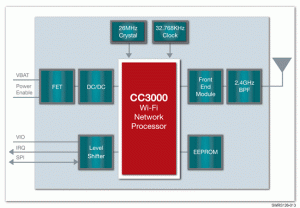Next in our series examining emerging power-efficient wireless chipsets, we consider the CC3000 series from Texas Instruments. As you may already understand, 802.11 wireless LAN standards are an attractive technology for building networks of wireless sensors and embedded devices due to industry familiarity and the availability of nearly ubiquitous existing network infrastructure.
The Texas Instruments CC3000 is a self-contained 802.11b/g wireless network processor that lowers the cost and complexity of adding Internet connectivity to an embedded Internet-of-Things network, allowing wireless LAN to be added to just about any existing microcontroller system relatively easily and at very low cost.
The CC3000 integrates the IPv4 TCP/IP stack, all the drivers and the security supplicant in the device, making it easily portable to lightweight microcontrollers without the memory burden of implementing a TCP/IP stack in the host microcontroller – a big advantage where relatively low-power, low-cost platforms such as 8-bit AVR or PIC microcontrollers with minimal memory are used. Furthermore, this compact module measures only 16.5mm x 11.5mm.
As it doesn’t require an external crystal or antenna balun, and in fact requires almost no external components except for an SPI interface to the host microcontroller, a regulated 3.3 volt supply, a few decoupling capacitors and antenna matching components and a 2.4 GHz 50-ohm antenna – and with a low cost of around ten dollars, the CC3000 is easy to design for and can meet many budgetary requirements.
This low cost is a game changer compared to most other embedded 802.11 solutions on the market at present, and allows wireless LAN connectivity to be added to existing embedded designs with relatively low complexity, minimal space, and a low cost. The flexible 2.7-4.8V voltage supply specification of the CC3000 offers great flexibility when combined with battery power or energy harvesting solutions (although 802.11 is not really intended as an ultra-low-power high-efficiency networking standard for battery powered wireless sensor networks and Internet-of-Things networks in the same way that, say, 802.1.4 or Bluetooth Low Energy are).
However, this chip is not a module with a built-in antenna or RF connector and a 50-ohm 2.4 GHz antenna must be added externally, meaning that the designer must have a little familiarity with microwave PCB design, such as microstrip transmission line layout and the choice of the right antenna connector. However, this offers the designer complete flexibility to choose the most appropriate architecture for the size, range and gain requirements of the design – a larger external antenna, a compact chip antenna, or an antenna designed into the PCB layout and fabricated as part of the PCB, with no component assembly required and no bill-of-materials cost.
Whilst development and evaluation boards for the CC3000 are available, this is perhaps one minor downside of the device’s small, ultra-compact package and lack of an integrated RF antenna – the design and fabrication of a custom microwave-capable printed circuit board is almost certainly required to use this device, especially if you decide for whatever reason that the existing evaluation boards are not suitable for your application.
Furthermore, the CC3000 is a relatively new device on the market, meaning that it may not have as much community support, documentation, community open-hardware following and a base of experienced users when compared to other, older wireless LAN chipsets or devices.
CC3000 reference designs available from Texas Instruments demonstrate chip-antenna based reference implementations that are already FCC, IC and CE certified, making it relatively easy to develop an 802.11-connected system that can pass compliance testing for products going into markets where such compliance is needed – provided the reference design is used without modification, with a chip antenna.
Additionally, the CC3000 is provided as a complete platform solution, with resources such as sample applications, API guides, porting guides and other extensive documentation provided and supported by TI.
The CC3000 library provided by TI for their MSP430 microcontroller family has recently been ported to the open-source Arduino platform by the developer community, allowing even a bare-bones Arduino-compatible AVR development board to connect to a wireless LAN using only a handful of components and only consuming about 12k of Flash and 350 bytes of RAM to run the open-source CC3000 library code, meaning that the Arduino still has sufficient resources left over to do many other interesting things.
An extra lightweight version of the library consumes somewhere between 2k and 6k of Flash, meaning that basic Internet connectivity is possible even on very small microcontrollers with very limited resources, such as the Atmel ATtiny series.
If you’re interested in designing around the TI CC3000 chipset but don’t have the expertise in PCB antenna design, embedded networking hardware – or just need to have it taken care of by an team of experts – but you’re not sure how to progress with a reliable implementation, we can partner with you to take care of this either in revisions of existing products or as part of new designs.
With our experience in retail and commercial products we have the ability to target your product’s design to the required end-user market and all the steps required to make it happen.
We can create or tailor just about anything from a wireless temperature sensor to a complete Internet-enabled system for you – within your required time-frame and your budget. For more information or a confidential discussion about your ideas and how we can help bring them to life – click here to contact us, or telephone 1800 810 124.
LX is an award-winning electronics design company based in Sydney, Australia. LX services include full turnkey design, electronics, hardware, software and firmware design. LX specialises in embedded systems and wireless technologies design. https://lx-group.com.au
Published by LX Pty Ltd for itself and the LX Group of companies, including LX Design House, LX Solutions and LX Consulting, LX Innovations.




